Lady Takeko Kujo and Me Beyond Time and Space
I would like to dedicate this article to Lady Takeko Kujo, a founder of my alma mater.
“This week is a tōban to clean up the ghost house. Who will open the front door? Let’s decide by jan-ken-pon.” It has been almost 50 years since I, as a student of the Kyoto Girls High School (KGHS), cleaned up the Kinkaden 錦華殿, as we called the Ghost House.
The front door squeaked and there was no light in the hallway. There were two oddball teachers using the Kinkaden for their office. I had no idea at that time that Lady Takeko Kujo (1887-1928) and her sister-in-law Kazuko had met there periodically over afternoon tea to plan a university for women.
Kazuko was the wife of the 22nd Kozui Gomonshu-sama. This couple, with Takeko and her husband Yoshimune (Kazuko’s younger brother), went on to the European tour in 1909 partly because Yoshimune got an assignment to work in the United Kingdom (UK).
Both women, who predicted the rise of Japanese women in the early 20th century, visited several girls’ high schools and universities in the UK, France and Germany. After returning to Japan, they requested Nishi Hongwanji support their plans to build a women’s university in Kyoto.
February is the month when Buddhist Women’s Association (BWA) members and friends of BCA temples hold the Kisaragi-ki (Kisaragi 如月 is another name of February and ki 忌 means a memorial) to remember Takeko and honor her life as a Shin Buddhist woman.
During her short 42 years of life, she encountered countless difficulties and sufferings. Kazuko, unfortunately, passed away at the age of 30 in 1911 soon after returning from Europe.
Takeko took over responsibilities from Kazuko in organizing the Fujinkai in Japan as the President. Then she followed her wish to pursue a higher educational institute for women based on Buddhist teaching, and later devoted her life as a humanitarian to help needy people affected in the Great Kantō earthquake in 1923. In 1920, Kyoto Joshi-kōtō-gakko was finally established, which became the current Kyoto Women’s University in 1949.
Takeko was talented, particularly in composing essays and poems. She contributed more than 100 essays to the Yomiuri newspaper in 1926, which were compiled and published in a book titled “Muyūge” in 1927. Takeko used the royalties from “Muyūge” to create a fund to build the Asoka Hospital, which was completed in 1930 after Takeko’s passing.
Born in the upper class and praised as one of the three beauties in the Taisho period, she could have had an easy life. Yet she accepted many challenges. One of my favorite poems composed by Takeko expresses the way she lived in the transient nature of this world:
Great Compassion from the Buddha always embraces and guides me Yet each of my steps is fragile and unstable.” (Original in Japanese: おほひなる もののちからにひかれゆく わがあしあとの おぼつかなしや)
She had no doubt of Amida’s sincere message. She realized the meaning of the Primal Vow that has its own karmic inevitability, which no human or divine forces can obstruct.
Her poem titled “Gassho From the Heart” reveals the true source of her resiliency and deep joy of living in Amida’s Light of Wisdom:
Trapped in a world of chaotic change, we seek an eternal, unchanging existence. There is nothing to rely on in this fleeting world; everything here is transient. There is not a thing to be proud of in this worldly life where our karma conditions dictate that we spend our lives chasing after illusions. Sadly, we try to hide our spiritual poverty by wrapping ourselves in the finery of grand illusions. Exhausted, we must walk a dark path of suffering that stretches endlessly into the distance. How sorry I feel for people caught in this state.
But when we openly lament the way we are, when we humbly place our hands in gassho from the heart, we will clearly see the bright torch raised high for lost and deluded seekers to gaze upon.
Though your august presence is unseen,
though your noble voice is unheard,
there is a dimension that I alone know,
where your Vow is ever working,
where your Light is ever shining.
As I kneel with hands placed together,
without a shred of doubt, I joyfully receive you,
with this gassho from my heart.
[Leaves of the My Heart,” American Buddhist Study Center, 2018, pages 54-55.]
OCBC will soon welcome the students of Kyoto Girls High School in early February. This is the school’s annual visit. What a karmic event that I will welcome my old school again at OCBC! I could not foresee this when I was cleaning the Ghost House.
Namo Amida Butsu
This is the current Kinkaden after renovation 25 years ago.

